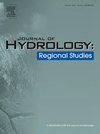Integrated flood modelling and risk assessment in urban areas: A review on applications, strengths, limitations and future research directions
IF 5
2区 地球科学
Q1 WATER RESOURCES
引用次数: 0
Abstract
Study region
Global scale.
Study focus
The purpose of this study is to provide a comprehensive global assessment of urban flood modelling by: (i) critically reviewing the most widely used flood models in urban settings; (ii) synthesizing their operational mechanisms, including the integration of diverse data types and validation techniques; and (iii) evaluating each model's strengths and limitations in simulating flood dynamics and assessing urban flood susceptibility. Furthermore, the paper establishes a framework for selecting acceptable modelling methodologies for successful flood risk management in real-world urban scenarios.
New hydrological insights for the region
Hydraulic-hydrological models, and cloud-based geospatial platforms have been widely applied in flood modelling and risk and vulnerability assessment. Despite these advancements, accurate flood modelling remains a challenge due to limitations in input data quality. Among earth observation tools, radar satellite data was identified as the most effective due to its reliability under cloudy and rainy conditions. Enhancing model accuracy and validation remains possible through the integration of both optical and radar data with hydraulic and hydrological models. For example, radar backscatter intensity can be used to estimate flood depths. However, key research gaps remain, notably, the integration of high-resolution climate projections and socio-economic factors into flood risk models, and the application of modelling tools in poorly planned urban areas to assess real-time changes in land use following flood events.
城市洪水综合建模与风险评估:应用、优势、局限及未来研究方向综述
研究区域和全球尺度。本研究的目的是通过以下方式对城市洪水模型进行全面的全球评估:(i)批判性地回顾在城市环境中最广泛使用的洪水模型;综合其业务机制,包括综合各种数据类型和验证技术;(3)评价各模型在模拟洪水动态和评估城市洪水易感性方面的优势和局限性。此外,本文还建立了一个框架,用于选择可接受的建模方法,以便在现实城市情景中成功地进行洪水风险管理。水力水文模型和基于云的地理空间平台已广泛应用于洪水建模和风险易损性评估。尽管取得了这些进步,但由于输入数据质量的限制,准确的洪水建模仍然是一个挑战。在对地观测工具中,雷达卫星数据因其在阴雨条件下的可靠性而被认为是最有效的。通过将光学和雷达数据与水力和水文模型相结合,仍然有可能提高模型的准确性和有效性。例如,雷达后向散射强度可以用来估计洪水深度。然而,关键的研究差距仍然存在,特别是将高分辨率气候预测和社会经济因素整合到洪水风险模型中,以及在规划不良的城市地区应用建模工具来评估洪水事件后土地利用的实时变化。
本文章由计算机程序翻译,如有差异,请以英文原文为准。
求助全文
约1分钟内获得全文
求助全文
来源期刊

Journal of Hydrology-Regional Studies
Earth and Planetary Sciences-Earth and Planetary Sciences (miscellaneous)
CiteScore
6.70
自引率
8.50%
发文量
284
审稿时长
60 days
期刊介绍:
Journal of Hydrology: Regional Studies publishes original research papers enhancing the science of hydrology and aiming at region-specific problems, past and future conditions, analysis, review and solutions. The journal particularly welcomes research papers that deliver new insights into region-specific hydrological processes and responses to changing conditions, as well as contributions that incorporate interdisciplinarity and translational science.
 求助内容:
求助内容: 应助结果提醒方式:
应助结果提醒方式:


